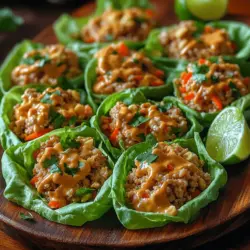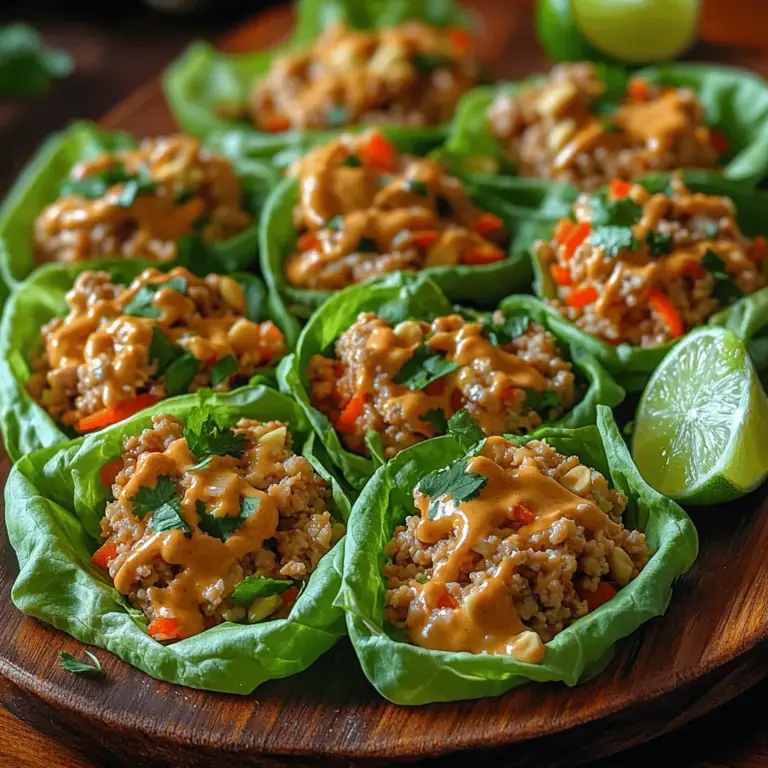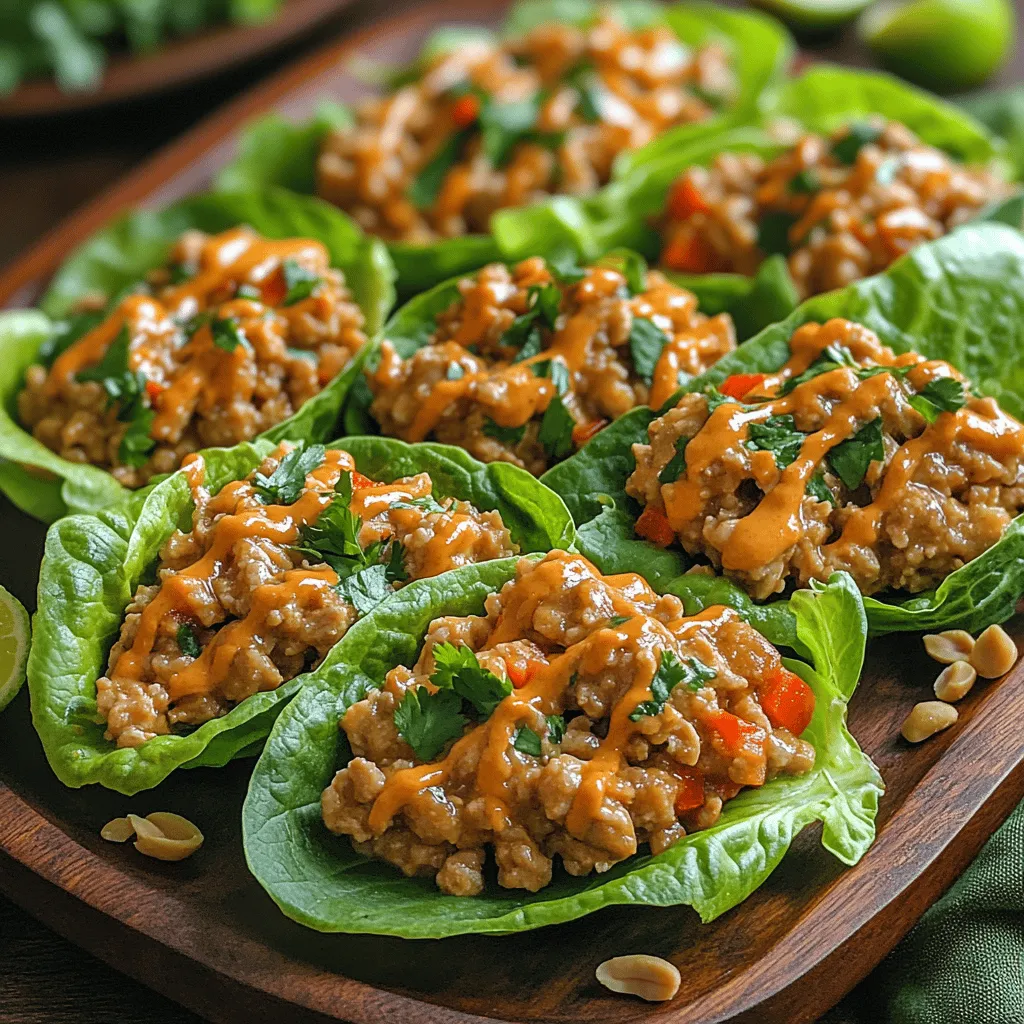Introduction
Thai cuisine has captured the hearts and palates of food lovers around the world with its vibrant flavors, aromatic spices, and fresh ingredients. Renowned for its balance of sweet, sour, salty, and spicy flavors, Thai food offers an exciting culinary adventure that tantalizes taste buds and satisfies cravings. One dish that embodies the essence of Thai cooking while also promoting healthy eating is Thai Peanut Chicken Lettuce Wraps.
These wraps combine the richness of ground chicken with the crunch of fresh vegetables, all enveloped in crispy lettuce leaves and drizzled with a luscious peanut sauce. They are not only delightful to eat but also incredibly easy to prepare, making them an ideal choice for busy weeknight dinners or casual gatherings. The health-conscious will appreciate their appeal as well, as they can fit perfectly into numerous diets—whether you are following a low-carb regimen, adhering to a gluten-free lifestyle, or simply seeking nutritious meal options.
What sets Thai Peanut Chicken Lettuce Wraps apart is their versatility; you can customize them to suit your taste preferences and dietary needs. With a few simple ingredients and steps, you can create a dish that is both satisfying and wholesome, showcasing the flavors of Thailand in the comfort of your own kitchen.
Understanding the Ingredients
To create delicious Thai Peanut Chicken Lettuce Wraps, it’s essential to understand the key ingredients that contribute to the dish’s flavor and texture. Fresh produce plays a crucial role in Thai cooking, and this recipe is no exception. Here’s a closer look at the main components:
Ground Chicken
Ground chicken serves as the primary protein source in this dish. It is lean, easy to cook, and absorbs flavors beautifully. When cooked correctly, ground chicken becomes tender and moist, making it an excellent filling for wraps. Moreover, it provides essential nutrients, including protein and B vitamins, which are vital for energy and overall health.
Fresh Produce
The freshness of vegetables is a hallmark of Thai cuisine, and Thai Peanut Chicken Lettuce Wraps highlight this principle. Ingredients such as bell peppers, carrots, and green onions not only add a burst of color but also enhance the dish’s nutritional profile. These vegetables are rich in vitamins and minerals, providing a crunchy texture that complements the softness of the chicken filling.
Lettuce
Lettuce leaves act as the perfect wrap for this dish, offering a low-calorie, low-carb alternative to traditional tortillas or bread. They provide a refreshing crunch and act as a natural vessel for the flavorful filling. Iceberg or butter lettuce are popular choices due to their sturdy structure and mild taste, making them ideal for holding the chicken and vegetables without tearing.
Sauces and Spices
The flavor profile of Thai Peanut Chicken Lettuce Wraps is defined by the combination of sauces and spices used in the recipe. Soy sauce, garlic, ginger, and peanut butter create a harmonious blend that is both savory and slightly sweet. These ingredients not only enhance the dish’s flavor but also contribute to its aromatic experience. The use of fresh garlic and ginger is essential, as they impart a depth of flavor that elevates the overall dish.
Health Benefits
Using lettuce as a wrap comes with several health benefits. Lettuce is low in calories and carbohydrates, making it an excellent choice for those looking to maintain or lose weight. Additionally, it is hydrating and packed with nutrients, including vitamins A and K, which are important for eye health and bone density, respectively. By opting for lettuce wraps instead of traditional bread or tortillas, you can enjoy a guilt-free, flavorful meal that aligns with your health goals.
Preparing the Peanut Sauce
No Thai dish would be complete without a rich and creamy peanut sauce that ties everything together. This sauce not only enhances the flavor of the chicken filling but also adds a delightful texture to the wraps. Here’s a detailed breakdown of how to prepare the peanut sauce:
Peanut Sauce Ingredients
To create the perfect peanut sauce, you will need the following ingredients:
– Peanut Butter: The star ingredient, providing creaminess and a distinct nutty flavor.
– Soy Sauce: Adds saltiness and umami, enhancing the overall taste of the sauce.
– Lime Juice: Introduces a bright acidity that balances the richness of the peanut butter.
– Honey or Maple Syrup: Adds a touch of sweetness to counteract the saltiness of the soy sauce.
– Garlic and Ginger: Freshly minced for an aromatic kick.
– Water: Adjusts the consistency of the sauce to your desired thickness.
– Chili Flakes or Sriracha: Optional, for those who enjoy a spicy kick in their peanut sauce.
Step-by-Step Process for Creating the Sauce
1. Combine Ingredients: In a medium bowl, add the peanut butter, soy sauce, lime juice, honey or maple syrup, minced garlic, and minced ginger.
2. Whisk Together: Using a whisk or fork, mix the ingredients until they are well combined and smooth.
3. Adjust Consistency: Gradually add water, a tablespoon at a time, until you reach your desired consistency. The sauce should be thick enough to coat the chicken filling but thin enough to drizzle easily.
4. Taste and Adjust: Taste the sauce and adjust seasoning as needed. If you prefer a spicier sauce, add chili flakes or a dash of Sriracha for heat.
Tips for Achieving the Perfect Consistency
– Use Creamy Peanut Butter: For a smoother sauce, opt for creamy peanut butter rather than chunky.
– Warmth Helps: Slightly warming the peanut butter before mixing can make it easier to incorporate other ingredients.
– Consistency Matters: If the sauce becomes too thin, add a bit more peanut butter to thicken it up.
Variations of Peanut Sauce
While the classic peanut sauce is delicious on its own, you can experiment with different flavors and ingredients to create variations:
– Spicy Peanut Sauce: Add more chili flakes, Sriracha, or even a splash of chili oil for a fiery kick.
– Creamy Coconut Peanut Sauce: Incorporate coconut milk for a richer, creamier texture and a hint of tropical flavor.
– Nut-Free Alternatives: Substitute peanut butter with sunbutter or tahini for a nut-free option.
Peanut sauce is a staple in Thai cuisine, often served alongside various dishes such as satay or drizzled over salads. Its versatility makes it an excellent addition to your culinary repertoire, allowing you to enhance a variety of dishes with its rich flavor.
Cooking the Chicken Filling
Once your peanut sauce is prepared, it’s time to cook the chicken filling. This step is crucial, as it lays the foundation for the flavor and texture of your Thai Peanut Chicken Lettuce Wraps.
Significance of Fresh Garlic and Ginger
Fresh garlic and ginger are non-negotiables in Thai cooking, providing aromatic depth and complexity. Garlic adds a savory note, while ginger offers warmth and a fragrant zing. Together, they form a flavorful base that elevates the ground chicken to new heights. Their health benefits, including anti-inflammatory properties and immune-boosting qualities, make them essential to this dish.
Step-by-Step Instructions for Cooking the Chicken Filling
1. Heat the Pan: Begin by heating a large skillet or wok over medium-high heat. Add a tablespoon of oil (such as vegetable or peanut oil) to the pan.
2. Sauté Aromatics: Once the oil is hot, add minced garlic and ginger. Sauté for about 30 seconds, stirring frequently to prevent burning. You want to release their flavors without browning them too much.
3. Add Ground Chicken: Add the ground chicken to the skillet. Use a wooden spoon or spatula to break it apart, ensuring even cooking.
4. Brown the Chicken: Allow the chicken to cook undisturbed for a few minutes until it starts to brown. This step is crucial, as browning adds a rich flavor that enhances the overall dish. Continue to stir and cook until the chicken is fully cooked through and no longer pink.
5. Incorporate Vegetables: Once the chicken is cooked, add your choice of diced vegetables (such as bell peppers, carrots, and onions) to the skillet. Stir to combine and cook for an additional 2-3 minutes until the vegetables are tender but still crisp.
6. Season the Filling: Pour in a few tablespoons of the prepared peanut sauce, stirring to coat the chicken and vegetables evenly. Cook for another minute, allowing the flavors to meld together.
Overview of How Vegetables Contribute to Texture and Nutrition
The addition of vegetables not only enhances the flavor and visual appeal of the dish but also contributes valuable nutrients. Bell peppers are rich in vitamin C, while carrots provide beta-carotene, an antioxidant that supports eye health. The crunch of these vegetables contrasts beautifully with the tender chicken, creating an enjoyable texture that makes each bite satisfying.
With the chicken filling prepared and bursting with flavor, you’re now ready to assemble your Thai Peanut Chicken Lettuce Wraps. The next steps will guide you through creating a delightful meal that your family and friends will love.
Insights into Balancing Flavors with Soy Sauce, Fish Sauce, and Lime Juice
Creating a well-balanced flavor profile is essential when preparing Thai Peanut Chicken Lettuce Wraps. The key components of this balance are soy sauce, fish sauce, and lime juice. Each ingredient contributes unique characteristics that enhance the overall taste of the dish.
Soy Sauce: This staple in Asian cuisine adds a rich umami flavor and saltiness, essential for bringing out the other ingredients’ flavors. When using soy sauce, opt for low-sodium varieties to control salt levels without sacrificing flavor.
Fish Sauce: Often considered the heart of Thai cuisine, fish sauce provides depth and a slight briny taste that elevates the dish. Its pungent aroma can be off-putting if used excessively, so start with a teaspoon and adjust according to your palate.
Lime Juice: Fresh lime juice adds brightness and acidity, cutting through the richness of the peanut sauce and enhancing the overall flavor. Use freshly squeezed lime juice for the best taste. The acidity also helps balance the salty elements, ensuring a harmonious blend of flavors.
Combining these three elements allows for a complex yet approachable flavor profile, ensuring each bite of the Thai Peanut Chicken Lettuce Wraps is delightful.
Assembling the Wraps
Assembling your Thai Peanut Chicken Lettuce Wraps is an art that requires a bit of finesse but is straightforward with the right approach. Follow these steps to create the perfect wrap.
Preparing Lettuce Leaves
1. Choose the Right Lettuce: For wraps, butter lettuce or romaine is ideal due to their pliability and sturdy structure. Look for leaves that are fresh, crisp, and intact.
2. Washing: Gently rinse the lettuce leaves under cold water to remove any dirt or impurities. Pat them dry using a clean kitchen towel or a salad spinner, being careful not to tear them.
3. Trimming: If the leaves are particularly large, you can trim the base with a sharp knife to make them easier to handle.
Tips for Perfecting the Assembly Process
1. Layering: Start with a lettuce leaf as your base. Add a spoonful of the peanut chicken mixture in the center of the leaf, being careful not to overfill.
2. Folding Technique: To wrap, fold the sides of the lettuce leaf over the filling, then roll from the bottom up. This technique helps secure the filling and makes for an easy-to-eat wrap.
3. Securing the Wrap: If necessary, use a toothpick to secure the wrap in place, especially if serving at a gathering.
Suggestions for Additional Toppings
Enhance the flavor and texture of your wraps by experimenting with various toppings:
– Fresh Herbs: Cilantro, mint, or basil can add a refreshing burst of flavor.
– Chopped Peanuts: For added crunch and nuttiness, sprinkle chopped roasted peanuts on top.
– Sliced Chili Peppers: If you enjoy heat, add thinly sliced red or green chili peppers for a spicy kick.
– Shredded Carrots: For extra crunch and a pop of color, top with shredded carrots.
Importance of Presentation and Serving Suggestions
A visually appealing dish enhances the dining experience. When plating your Thai Peanut Chicken Lettuce Wraps, consider using a large platter lined with fresh lettuce leaves. Arrange the wraps neatly and garnish with additional herbs and lime wedges for a vibrant look.
Serving Suggestions
The way you serve your Thai Peanut Chicken Lettuce Wraps can elevate your dining experience. Here are some suggestions to consider:
1. Plating: Serve the wraps on a large platter, garnished with lime wedges and fresh herbs. This communal style encourages sharing and enhances the meal’s social aspect.
2. Complementary Side Dishes: Pair your wraps with light sides such as:
– Thai Cucumber Salad: Refreshing and tangy, this salad complements the richness of the peanut sauce.
– Steamed Jasmine Rice: A small portion of rice can balance the meal without overshadowing the wraps.
– Spring Rolls: Fresh or fried spring rolls can add variety and texture to the meal.
3. Beverage Pairings: Enhance your dining experience with beverages that complement the flavors. A chilled Thai iced tea or a light beer, such as a lager, works well. For a non-alcoholic option, consider coconut water or sparkling water with lime.
4. Suitability for Various Occasions: Thai Peanut Chicken Lettuce Wraps are versatile enough for different occasions. They make a fantastic appetizer for dinner parties or a quick yet impressive weeknight meal. Their interactive nature encourages guests to customize their wraps, making them perfect for gatherings.
Nutritional Benefits of Thai Peanut Chicken Lettuce Wraps
Thai Peanut Chicken Lettuce Wraps are not only delicious but also packed with nutritional benefits. Here’s a breakdown of the key components:
1. Lean Protein: Chicken breast is an excellent source of lean protein, essential for muscle repair and growth. It’s a great way to stay satiated while maintaining a balanced diet.
2. Fresh Vegetables: The lettuce and other toppings like carrots and herbs add fiber, vitamins, and minerals. Fiber aids digestion and helps maintain a healthy weight.
3. Healthy Fats: The peanut sauce, made from natural peanut butter, provides healthy fats that are beneficial for heart health.
4. Dietary Considerations: This dish can easily cater to various dietary preferences:
– Low-Carb: The use of lettuce instead of traditional wraps makes it a fantastic low-carb option.
– Gluten-Free: By using gluten-free soy sauce or tamari, you can ensure this dish is suitable for those with gluten sensitivities.
– Homemade Sauces: Making your peanut sauce allows you to control the ingredients, avoiding preservatives and additives commonly found in store-bought versions.
Cultural Significance of Lettuce Wraps in Thai Cuisine
Lettuce wraps have a rich history in Thai and broader Asian cuisines. They are often seen as a communal dish, symbolizing sharing and togetherness among diners.
1. Historical Context: Traditionally, lettuce wraps were a practical way to consume meals. They allow for easy handling of foods and reduce the need for utensils, making them ideal for street food culture in Thailand.
2. Regional Variations: While Thai cuisine prominently features lettuce wraps, variations exist across different cultures. For instance, Korean ssam uses leafy vegetables to wrap grilled meats and condiments, showcasing a similar communal dining experience.
3. Social Dining: Lettuce wraps encourage diners to engage with their food and each other. The assembly process allows for creativity and personal preference, making it a fun and interactive dining experience.
Conclusion
Thai Peanut Chicken Lettuce Wraps offer an exciting blend of flavors and textures that are both satisfying and healthy. The ease of preparation, combined with the versatility of serving options, makes this dish a fantastic choice for any occasion.
Whether you’re hosting a dinner party or looking for a quick weeknight meal, these wraps will impress your guests and provide a delightful dining experience. Encouraging readers to embrace the joy of cooking and crafting their wraps is an invitation to explore the rich flavors of Thai cuisine at home. So gather your ingredients, balance those flavors, and enjoy the deliciousness of homemade Thai Peanut Chicken Lettuce Wraps.



